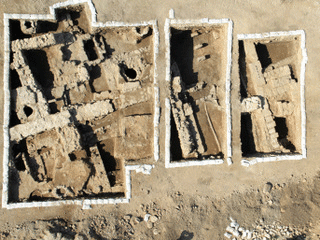Archaeological Discoveries: 1,500 Year Old Public Building Uncovered in Akko
(June 2011)
Archaeological Discoveries: Archaeological Discoveries: Table of Contents
For the first time in the history of the study of Akko, a public building from the Byzantine period has been exposed in the city.
In an archaeological excavation the Israel Antiquities Authority conducted c. 100 m west of Tel Akko – next to the Azrieli Shopping Mall compound under construction there – a 1,500 year old public building was discovered that may have been used as a church. The salvage excavation was carried out there as a result of work that had not been coordinated with the IAA and which caused damage to ancient remains located in a declared antiquities site
 |
The early Christian sources mention the bishops of Akko and Caesarea who participated in major international conferences and meetings that dealt with formulating religious doctrine, thus attesting to the centrality of Akko for the Christian religion in this period. In addition, we also have evidence of an anonymous pilgrim from the city of Piacenza in Italy, regarding the richness and splendor of the city in the year 570 CE, in which he mentions the beautiful churches within its precincts.
The paucity of Byzantine remains that have been found so far can be attributed to the destruction caused by those who came thereafter. In addition, earlier structures that date to the Hellenistic period were exposed beneath the foundations of the Byzantine public building. Their contents were rich and diverse and
Sources: Israel Antiquities Authority


